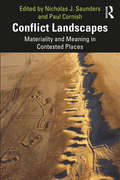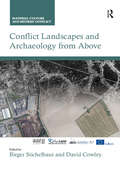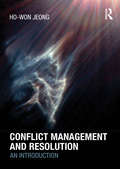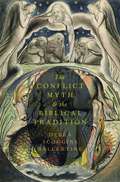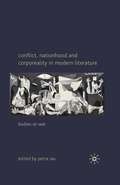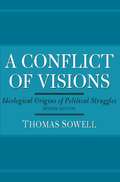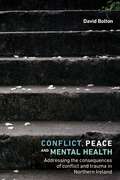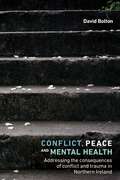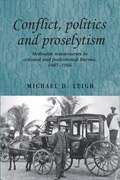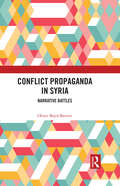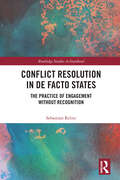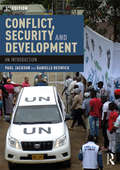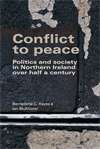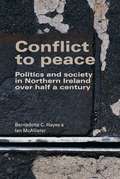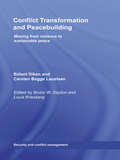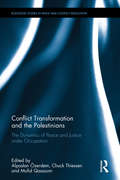- Table View
- List View
Conflict Landscapes: Materiality and Meaning in Contested Places
by Nicholas J. Saunders and Paul CornishConflict Landscapes explores the long under-acknowledged and under-investigated aspects of where and how modern conflict landscapes interact and conjoin with pre-twentieth-century places, activities, and beliefs, as well as with individuals and groups. Investigating and understanding the often unpredictable power and legacies of landscapes that have seen (and often still viscerally embody) the consequences of mass death and destruction, the book shows, through these landscapes, the power of destruction to preserve, refocus, and often reconfigure the past. Responding to the complexity of modern conflict, the book offers a coherent, integrated, and sensitized hybrid approach, which calls on different disciplines where they overlap in a shared common terrain. Dealing with issues such as memory, identity, emotion, and wellbeing, the chapters tease out the human experience of modern conflict and its relationship to landscape. Conflict Landscapes will appeal to a wide range of disciplines involved in studying conflict, such as archaeology, anthropology, material culture studies, art history, cultural history, cultural geography, military history, and heritage and museum studies.
Conflict Landscapes: Materiality and Meaning in Contested Places
by Nicholas J. Saunders Paul CornishConflict Landscapes explores the long under-acknowledged and under-investigated aspects of where and how modern conflict landscapes interact and conjoin with pre-twentieth-century places, activities, and beliefs, as well as with individuals and groups. Investigating and understanding the often unpredictable power and legacies of landscapes that have seen (and often still viscerally embody) the consequences of mass death and destruction, the book shows, through these landscapes, the power of destruction to preserve, refocus, and often reconfigure the past. Responding to the complexity of modern conflict, the book offers a coherent, integrated, and sensitized hybrid approach, which calls on different disciplines where they overlap in a shared common terrain. Dealing with issues such as memory, identity, emotion, and wellbeing, the chapters tease out the human experience of modern conflict and its relationship to landscape. Conflict Landscapes will appeal to a wide range of disciplines involved in studying conflict, such as archaeology, anthropology, material culture studies, art history, cultural history, cultural geography, military history, and heritage and museum studies.
Conflict Landscapes and Archaeology from Above (Material Culture and Modern Conflict)
by Birger Stichelbaut David CowleyThe study of conflict archaeology has developed rapidly over the last decade, fuelled in equal measure by technological advances and creative analytical frameworks. Nowhere is this truer than in the inter-disciplinary fields of archaeological practice that combine traditional sources such as historical photographs and maps with 3D digital topographic data from Airborne Laser Scanning (ALS) and large scale geophysical prospection. For twentieth-century conflict landscapes and their surviving archaeological remains, these developments have encouraged a shift from a site oriented approach towards landscape-scaled research. This volume brings together an wide range of perspectives, setting traditional approaches that draw on historical and contemporary aerial photographs alongside cutting-edge prospection techniques, cross-disciplinary analyses and innovative methods of presenting this material to audiences. Essays from a range of disciplines (archaeology, history, geography, heritage and museum studies) studying conflict landscapes across the globe throughout the twentieth century, all draw on aerial and landscape perspectives to past conflicts and their legacy and the complex issues for heritage management. Organized in four parts, the first three sections take a broadly chronological approach, exploring the use of aerial evidence to expand our understanding of the two World Wars and the Cold War. The final section explores ways that the aerial perspective can be utilized to represent historical landscapes to a wide audience. With case studies ranging from the Western Front to the Cold War, Ireland to Russia, this volume demonstrates how an aerial perspective can both support and challenge traditional archaeological and historical analysis, providing an innovative new means of engaging with the material culture of conflict and commemoration.
Conflict Landscapes and Archaeology from Above (Material Culture and Modern Conflict)
by Birger Stichelbaut David CowleyThe study of conflict archaeology has developed rapidly over the last decade, fuelled in equal measure by technological advances and creative analytical frameworks. Nowhere is this truer than in the inter-disciplinary fields of archaeological practice that combine traditional sources such as historical photographs and maps with 3D digital topographic data from Airborne Laser Scanning (ALS) and large scale geophysical prospection. For twentieth-century conflict landscapes and their surviving archaeological remains, these developments have encouraged a shift from a site oriented approach towards landscape-scaled research. This volume brings together an wide range of perspectives, setting traditional approaches that draw on historical and contemporary aerial photographs alongside cutting-edge prospection techniques, cross-disciplinary analyses and innovative methods of presenting this material to audiences. Essays from a range of disciplines (archaeology, history, geography, heritage and museum studies) studying conflict landscapes across the globe throughout the twentieth century, all draw on aerial and landscape perspectives to past conflicts and their legacy and the complex issues for heritage management. Organized in four parts, the first three sections take a broadly chronological approach, exploring the use of aerial evidence to expand our understanding of the two World Wars and the Cold War. The final section explores ways that the aerial perspective can be utilized to represent historical landscapes to a wide audience. With case studies ranging from the Western Front to the Cold War, Ireland to Russia, this volume demonstrates how an aerial perspective can both support and challenge traditional archaeological and historical analysis, providing an innovative new means of engaging with the material culture of conflict and commemoration.
Conflict Management and Resolution: An Introduction
by Ho-Won JeongConflict Management and Resolution provides students with an overview of the main theories of conflict management and conflict resolution, and will equip them to respond to the complex phenomena of international conflict. The book covers these four key concepts in detail: negotiation mediation facilitation reconciliation. It examines how to prevent, manage and eventually resolve various types of conflict that originate from inter-state and inter-group competition, and expands the existing scope of conflict management and resolution theories by examining emerging theories on the identity, power and structural dimensions of adversarial relationships. The volume is designed to enhance our understanding of effective response strategies to conflict in multiple social settings as well as violent struggles, and utilizes numerous case studies, both past and current. These include the Iranian and North Korean nuclear weapons programmes, the war in Lebanon, the Arab-Israeli conflict, civil wars in Africa, and ethnic conflicts in Europe and Asia. This book will be essential reading for all students of conflict management and resolution, mediation, peacekeeping, peace and conflict studies and International Relations in general. Ho-Won Jeong is Professor of Conflict Analysis and Resolution, George Mason University, USA. He has published nine books in the field of international relations, peace and conflict studies. He is also a senior editor of the International Journal of Peace Studies.
Conflict Management and Resolution: An Introduction
by Ho-Won JeongConflict Management and Resolution provides students with an overview of the main theories of conflict management and conflict resolution, and will equip them to respond to the complex phenomena of international conflict. The book covers these four key concepts in detail: negotiation mediation facilitation reconciliation. It examines how to prevent, manage and eventually resolve various types of conflict that originate from inter-state and inter-group competition, and expands the existing scope of conflict management and resolution theories by examining emerging theories on the identity, power and structural dimensions of adversarial relationships. The volume is designed to enhance our understanding of effective response strategies to conflict in multiple social settings as well as violent struggles, and utilizes numerous case studies, both past and current. These include the Iranian and North Korean nuclear weapons programmes, the war in Lebanon, the Arab-Israeli conflict, civil wars in Africa, and ethnic conflicts in Europe and Asia. This book will be essential reading for all students of conflict management and resolution, mediation, peacekeeping, peace and conflict studies and International Relations in general. Ho-Won Jeong is Professor of Conflict Analysis and Resolution, George Mason University, USA. He has published nine books in the field of international relations, peace and conflict studies. He is also a senior editor of the International Journal of Peace Studies.
The Conflict Myth and the Biblical Tradition
by Debra Scoggins BallentineThere are many ancient West Asian stories that narrate the victory of a warrior deity over an enemy, typically a sea-god or sea dragon, and his rise to divine kingship. In The Conflict Myth and the Biblical Tradition, Debra Scoggins Ballentine analyzes this motif, arguing that it was used within ancient political and socio-religious discourses to bolster particular divine hierarchies, kings, institutions, and groups, as well as to attack others. Situating her study of the conflict topos within contemporary theorizations of myth by Bruce Lincoln, Russell McCutcheon, and Jonathan Z. Smith, Ballentine examines narratives of divine combat and instances of this conflict motif. Her study cuts across traditional disciplinary boundaries as well as constructed time periods, focusing not only on the Hebrew Bible but also incorporating Mesopotamian, early Jewish, early Christian, and rabbinic texts, spanning a period of almost three millennia - from the eighteenth century BCE to the early middle ages CE. The Conflict Myth and the Biblical Tradition advances our understanding of the conflict topos in ancient west Asian and early Jewish and Christian literatures and of how mythological and religious ideas are used both to validate and render normative particular ideologies and socio-political arrangements, and to delegitimize and invalidate others.
The Conflict Myth and the Biblical Tradition
by Debra Scoggins BallentineThere are many ancient West Asian stories that narrate the victory of a warrior deity over an enemy, typically a sea-god or sea dragon, and his rise to divine kingship. In The Conflict Myth and the Biblical Tradition, Debra Scoggins Ballentine analyzes this motif, arguing that it was used within ancient political and socio-religious discourses to bolster particular divine hierarchies, kings, institutions, and groups, as well as to attack others. Situating her study of the conflict topos within contemporary theorizations of myth by Bruce Lincoln, Russell McCutcheon, and Jonathan Z. Smith, Ballentine examines narratives of divine combat and instances of this conflict motif. Her study cuts across traditional disciplinary boundaries as well as constructed time periods, focusing not only on the Hebrew Bible but also incorporating Mesopotamian, early Jewish, early Christian, and rabbinic texts, spanning a period of almost three millennia - from the eighteenth century BCE to the early middle ages CE. The Conflict Myth and the Biblical Tradition advances our understanding of the conflict topos in ancient west Asian and early Jewish and Christian literatures and of how mythological and religious ideas are used both to validate and render normative particular ideologies and socio-political arrangements, and to delegitimize and invalidate others.
Conflict, Nationhood and Corporeality in Modern Literature: Bodies-at-War
by Petra RauThis collection examines ways in which modern literature responds to the body-at-war, examining the effects of violent conflict on the body in its literal and representative forms. Spanning literature from World War I to the present day, it includes essays on pacifist theatre, torture, fascist fantasies, and uniforms and masculinity.
A Conflict of Visions: Ideological Origins of Political Struggles
by Thomas SowellThomas Sowell's classic analysis of the opposing visions behind today's ethical and ideological disputesControversies in politics arise from many sources, but the conflicts that endure for generations or centuries show a remarkably consistent pattern. This revised edition of a classic analyzes the centuries-long debates about the nature of reason, justice, equality, and power. It distinguishes between those with the "constrained" vision, which sees human nature as enduring and self-centered, and the "unconstrained" vision, in which human nature is malleable and perfectible. A Conflict of Visions offers a compelling case that these opposing visions are behind the ethical and ideological disputes of yesterday and today.
Conflict, peace and mental health: Addressing the consequences of conflict and trauma in Northern Ireland
by David BoltonWhat are the human consequences of conflict and what are the appropriate service responses? This book seeks to provide an answer to these important questions, drawing on over twenty-five years of work by the author in Northern Ireland and elsewhere. Focusing on the work undertaken following the Omagh bombing, the book describes how needs were assessed and understood, how evidence-based services were put in place, and the training and education programmes that were developed to assist first those communities affected by the bombing and later the wider population affected by the years of conflict. The author places the mental-health needs of affected communities at the heart of the political and peace processes that follow. This is a practical book and will be of particular interest to those planning for and responding to conflict-related disasters, policy makers, service commissioners and providers, politicians, civil servants and peace makers.
Conflict, peace and mental health: Addressing the consequences of conflict and trauma in Northern Ireland (G - Reference, Information And Interdisciplinary Subjects Ser.)
by David BoltonWhat are the human consequences of conflict and what are the appropriate service responses? This book seeks to provide an answer to these important questions, drawing on over twenty-five years of work by the author in Northern Ireland and elsewhere. Focusing on the work undertaken following the Omagh bombing, the book describes how needs were assessed and understood, how evidence-based services were put in place, and the training and education programmes that were developed to assist first those communities affected by the bombing and later the wider population affected by the years of conflict. The author places the mental-health needs of affected communities at the heart of the political and peace processes that follow. This is a practical book and will be of particular interest to those planning for and responding to conflict-related disasters, policy makers, service commissioners and providers, politicians, civil servants and peace makers.
Conflict, Politics and Proselytism: Methodist missionaries in colonial and postcolonial Burma, 1887–1966 (Studies in Imperialism)
by Michael D. LeighThis book is a study of the ambitions, activities and achievements of Methodist missionaries in northern Burma from 1887-1966 and the expulsion of the last missionaries by Ne Win. The story is told through painstaking original research in archives which contain thousands of hitherto unpublished documents and eyewitness accounts meticulously recorded by the Methodist missionaries. This accessible study constitutes a significant contribution to a very little-known area of missionary history. Leigh pulls together the themes of conflict, politics and proselytisation in to a fascinating study of great breadth. The historical nuances of the relationship between religion and governance in Burma are traced in an accessible style. This book will appeal to those teaching or studying colonial and postcolonial history, Burmese politics, and the history of missionary work.
Conflict Propaganda in Syria: Narrative Battles
by Oliver Boyd-BarrettThis book investigates rival narratives about the conflict in Syria from 2011 onwards. It examines the starkly different narratives about the Syrian conflict told by mainly Western mainstream and alternative media, and contrasts these narratives with the equally polarized but more nuanced narratives of mainly western scholars and long-form journalists. Differences of narrative concerning the conflict include: what is deemed relevant context in trying to explain the war; whether the war is best seen as a civil conflict or as a proxy war fought among external powers; the degree of emphasis given to the alleged crimes of the Syrian regime as opposed to the alleged violence of Salafist militia; the accuracy of the "origin" story of the conflict in Daraa; the extent to which the initial protestors were secular campaigners calling for democracy or whether they were Muslim extremists seeking a sectarian society governed by sharia law. Several case studies of propaganda institutions are examined here, including the journalism of Marie Colvin; the role of government-funded NGOs; the controversies surrounding each of three major instances of alleged regime use of chemical weapons, and the politicization of the Organization for the Prohibition of Chemical Weapons (OPCW). This book will be of much interest to students of media and communication studies, propaganda studies, Middle Eastern politics, and International Relations in general.
Conflict Propaganda in Syria: Narrative Battles
by Oliver Boyd-BarrettThis book investigates rival narratives about the conflict in Syria from 2011 onwards. It examines the starkly different narratives about the Syrian conflict told by mainly Western mainstream and alternative media, and contrasts these narratives with the equally polarized but more nuanced narratives of mainly western scholars and long-form journalists. Differences of narrative concerning the conflict include: what is deemed relevant context in trying to explain the war; whether the war is best seen as a civil conflict or as a proxy war fought among external powers; the degree of emphasis given to the alleged crimes of the Syrian regime as opposed to the alleged violence of Salafist militia; the accuracy of the "origin" story of the conflict in Daraa; the extent to which the initial protestors were secular campaigners calling for democracy or whether they were Muslim extremists seeking a sectarian society governed by sharia law. Several case studies of propaganda institutions are examined here, including the journalism of Marie Colvin; the role of government-funded NGOs; the controversies surrounding each of three major instances of alleged regime use of chemical weapons, and the politicization of the Organization for the Prohibition of Chemical Weapons (OPCW). This book will be of much interest to students of media and communication studies, propaganda studies, Middle Eastern politics, and International Relations in general.
Conflict Resolution in De Facto States: The Practice of Engagement without Recognition (Routledge Studies in Statehood)
by Sebastian RelitzThis book explores the challenges of conflict resolution in protracted conflicts and conceptualises and analyses the practice of engagement without recognition in de facto states. Increasingly, engagement without recognition is seen as a promising approach to conflict resolution in de facto states, but little is known about its implementation and results. This book addresses that lacuna and develops an analytical model to assess international engagement, focusing on implementation on the ground. This model enables a comprehensive analysis of international engagement's scope, areas, and methods. Further, the book also explores the context of engagement in de facto states, which has a significant impact on its implementation and results. In this way, the book also advances our understanding of the opportunities, obstacles, and limitations of engagement without recognition. The analysis is based on the current EU engagement in Abkhazia and draws from other cases in the Caucasus, Eastern Europe, and beyond and finds that international engagement with de facto states is more comprehensive and multifaceted than previously known. However, it also faces some distinct challenges and produces modest results. Finally, the book provides practical recommendations on how to better utlilise the peacebuilding potential of engagement without recognition. This book will be of much interest to students of conflict resolution, statehood, peace and conflict studies, and international relations.
Conflict Resolution in De Facto States: The Practice of Engagement without Recognition (Routledge Studies in Statehood)
by Sebastian RelitzThis book explores the challenges of conflict resolution in protracted conflicts and conceptualises and analyses the practice of engagement without recognition in de facto states. Increasingly, engagement without recognition is seen as a promising approach to conflict resolution in de facto states, but little is known about its implementation and results. This book addresses that lacuna and develops an analytical model to assess international engagement, focusing on implementation on the ground. This model enables a comprehensive analysis of international engagement's scope, areas, and methods. Further, the book also explores the context of engagement in de facto states, which has a significant impact on its implementation and results. In this way, the book also advances our understanding of the opportunities, obstacles, and limitations of engagement without recognition. The analysis is based on the current EU engagement in Abkhazia and draws from other cases in the Caucasus, Eastern Europe, and beyond and finds that international engagement with de facto states is more comprehensive and multifaceted than previously known. However, it also faces some distinct challenges and produces modest results. Finally, the book provides practical recommendations on how to better utlilise the peacebuilding potential of engagement without recognition. This book will be of much interest to students of conflict resolution, statehood, peace and conflict studies, and international relations.
Conflict, Security and Development: An Introduction
by Paul Jackson Danielle BeswickThis textbook draws on academic theory, field research and policy developments to provide an overview of the connections between security and development, before, during and after conflict. This third edition is revised and updated to take account of changes that have occurred in both policy and academic arenas which are relevant to students and practitioners in this area. In addition, there is a new chapter on memory and memorialisation after conflict. In an interdependent world, it is often argued that the challenges of underdevelopment and insecurity have global implications. This textbook charts an accessible course through these complex debates, providing a comprehensive introduction for those encountering these issues for the first time. The main aims of the revised edition are: to set out how thinking on conflict, security and development has changed over time and continues to evolve; to explore the consequences of these changes, particularly for the theory and practice of development and security promotion; to introduce a range of case studies from across the globe, in order to explore the implications of a combined approach to security and development. The authors are experienced in both the theory and the practice of this field, and illustrate the links between conflict, security and development with practical examples, drawing on key case studies from the past twenty years. Each chapter is informed by student pedagogy, and the book will be essential reading for all students of development studies, war and conflict studies, and human security, and is recommended for students of international security and international relations in general.
Conflict, Security and Development: An Introduction
by Paul Jackson Danielle BeswickThis textbook draws on academic theory, field research and policy developments to provide an overview of the connections between security and development, before, during and after conflict. This third edition is revised and updated to take account of changes that have occurred in both policy and academic arenas which are relevant to students and practitioners in this area. In addition, there is a new chapter on memory and memorialisation after conflict. In an interdependent world, it is often argued that the challenges of underdevelopment and insecurity have global implications. This textbook charts an accessible course through these complex debates, providing a comprehensive introduction for those encountering these issues for the first time. The main aims of the revised edition are: to set out how thinking on conflict, security and development has changed over time and continues to evolve; to explore the consequences of these changes, particularly for the theory and practice of development and security promotion; to introduce a range of case studies from across the globe, in order to explore the implications of a combined approach to security and development. The authors are experienced in both the theory and the practice of this field, and illustrate the links between conflict, security and development with practical examples, drawing on key case studies from the past twenty years. Each chapter is informed by student pedagogy, and the book will be essential reading for all students of development studies, war and conflict studies, and human security, and is recommended for students of international security and international relations in general.
Conflict to peace: Politics and society in Northern Ireland over half a century (PDF)
by Ian Mcallister Bernadette HayesAfter three decades of violence, Northern Ireland has experienced unprecedented peace. This book, now available in paperback, examines the impact of the 1998 Agreement which halted the violence on those most affected by it – the Northern Irish people themselves. Using public opinion surveys conducted over a period of half a century, this book covers changes in public opinion across all areas of society and politics, including elections, education, community relations and national identity. The surveys show that despite peace, Protestants and Catholics remain as deeply divided as ever. The vast majority marry co-religionists, attend religious schools and have few friends across the religious divide. The results have implications not just for peacemaking in Northern Ireland, but for other societies emerging from conflict. The main lesson of peacemaking in Northern Ireland is that political reform has to be accompanied by social change across the society as a whole. Peace after conflict needs social as well as political change.
Conflict to peace: Politics and society in Northern Ireland over half a century
by Ian Mcallister Bernadette HayesAfter three decades of violence, Northern Ireland has experienced unprecedented peace. This book, now available in paperback, examines the impact of the 1998 Agreement which halted the violence on those most affected by it – the Northern Irish people themselves. Using public opinion surveys conducted over a period of half a century, this book covers changes in public opinion across all areas of society and politics, including elections, education, community relations and national identity. The surveys show that despite peace, Protestants and Catholics remain as deeply divided as ever. The vast majority marry co-religionists, attend religious schools and have few friends across the religious divide. The results have implications not just for peacemaking in Northern Ireland, but for other societies emerging from conflict. The main lesson of peacemaking in Northern Ireland is that political reform has to be accompanied by social change across the society as a whole. Peace after conflict needs social as well as political change.
Conflict Transformation and Peacebuilding: Moving From Violence to Sustainable Peace (Routledge Studies in Security and Conflict Management)
by Bruce W. Dayton Louis KriesbergThis book seeks to examine the causes of escalation and de-escalation in intrastate conflicts. Specifically, the volume seeks to map the processes and dynamics that lead groups challenging existing power structures to engage in violent struggle; the processes and dynamics that contribute to the de-escalation of violent struggle and the participation of challengers in peaceful political activities; and the processes and dynamics that sustain and nurture this transformation. By integrating the latest ideas with richly presented case studies, this volume fills a gap in our understanding of the forces that lead to moderation and constructive engagement in the context of violent, intrastate conflicts. This volume will be of great interest to students of conflict management, peace studies, conflict resolution, ethnic conflict and security studies in general.
Conflict Transformation and Peacebuilding: Moving From Violence to Sustainable Peace (Routledge Studies in Security and Conflict Management)
by Bruce W. Dayton Louis KriesbergThis book seeks to examine the causes of escalation and de-escalation in intrastate conflicts. Specifically, the volume seeks to map the processes and dynamics that lead groups challenging existing power structures to engage in violent struggle; the processes and dynamics that contribute to the de-escalation of violent struggle and the participation of challengers in peaceful political activities; and the processes and dynamics that sustain and nurture this transformation. By integrating the latest ideas with richly presented case studies, this volume fills a gap in our understanding of the forces that lead to moderation and constructive engagement in the context of violent, intrastate conflicts. This volume will be of great interest to students of conflict management, peace studies, conflict resolution, ethnic conflict and security studies in general.
Conflict Transformation and the Palestinians: The Dynamics of Peace and Justice under Occupation (Routledge Studies in Peace and Conflict Resolution)
by Alpaslan Ozerdem Chuck Thiessen Mufid QassoumThis book explores the challenges of transforming the violent conflict between the State of Israel and the Palestinians into just peace. There are many challenges involved in the bottom-up transformation of the violent structures that sustain the State of Israel’s occupation of Palestinian territory. This book examines these structures as it assesses the actors and strategies that are contributing to the termination of cycles of violence and oppression. Consisting of contributions from both peace practitioners and academics who have conducted research within Israel and the occupied territory, the volume utilises a multidisciplinary perspective to examine promising strategies for conflict transformation in Israel and the occupied Palestinian territory. Moreover, it spells out the types of nonviolent strategy that are being used to expose and undermine occupation structures, and surveys the manner in which a variety of key actors are working towards the transformation of the ongoing conflict. As a whole, the volume presents a proposal for the transformation of the conflict between Palestinians and the State of Israel that embraces the constructive potential of conflict, engages with power asymmetry, and pushes for justice and accountability. This book will be of much interest to students of conflict resolution, peace studies, Middle Eastern studies, the Arab-Israeli conflict, and IR in general.
Conflict Transformation and the Palestinians: The Dynamics of Peace and Justice under Occupation (Routledge Studies in Peace and Conflict Resolution)
by Alpaslan Ozerdem Chuck Thiessen Mufid QassoumThis book explores the challenges of transforming the violent conflict between the State of Israel and the Palestinians into just peace. There are many challenges involved in the bottom-up transformation of the violent structures that sustain the State of Israel’s occupation of Palestinian territory. This book examines these structures as it assesses the actors and strategies that are contributing to the termination of cycles of violence and oppression. Consisting of contributions from both peace practitioners and academics who have conducted research within Israel and the occupied territory, the volume utilises a multidisciplinary perspective to examine promising strategies for conflict transformation in Israel and the occupied Palestinian territory. Moreover, it spells out the types of nonviolent strategy that are being used to expose and undermine occupation structures, and surveys the manner in which a variety of key actors are working towards the transformation of the ongoing conflict. As a whole, the volume presents a proposal for the transformation of the conflict between Palestinians and the State of Israel that embraces the constructive potential of conflict, engages with power asymmetry, and pushes for justice and accountability. This book will be of much interest to students of conflict resolution, peace studies, Middle Eastern studies, the Arab-Israeli conflict, and IR in general.
